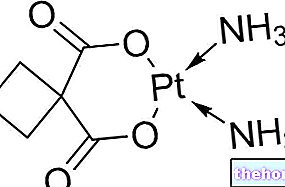Generality
Clavulanic acid is a compound with a chemical structure of the beta-lactam (or β-lactam) type. In particular, clavulanic acid is a β-lactamase inhibitor that is widely used in medicinal preparations in association with drugs antibiotics, such as penicillins.

Uses of Clavulanic Acid
Although clavulanic acid has a weak antibacterial activity, its use in medicinal preparations with antibiotic action is not carried out for its direct action against microorganisms, but for its ability to inhibit particular enzymes produced by different strains bacterial: β-lactamases (or beta-lactamases).
Β-lactamases are particular enzymes (more precisely, serine proteases) produced by certain bacterial strains, to which they confer resistance to antibiotics with a beta-lactam chemical structure (such as, for example, penicillins). In fact, the task of these enzymes is precisely to break the beta-lactam ring present in the structure of the aforementioned antibiotic drugs, irreversibly compromising their activity and allowing the bacteria to survive.
Clavulanic acid is used above all in association with amoxicillin (a semi-synthetic penicillin with a broad spectrum of action). There are several medicinal preparations based on amoxicillin and clavulanic acid on the market; among the best known we remember Augmentin® and the Clavulin®.
Mechanism of action
As mentioned, clavulanic acid is an irreversible inhibitor of the aforementioned beta-lactamases. Having a beta-lactam chemical structure, clavulanic acid is able to bind to these enzymes preferentially with respect to penicillins.
More specifically, clavulanic acid - by binding to beta-lactamases instead of penicillins - causes irreversible acylation of the hydroxyl of the serine present in the active site of the same enzyme, inhibiting it.
In truth, some types of beta-lactamase are able to hydrolyze clavulanic acid; however, following this hydrolysis, subsequent chemical reactions take place which in any case and irremediably lead to the inhibition of the enzyme, thus allowing to obtain in any case the desired effect.
Precisely by virtue of this mechanism of action, clavulanic acid falls into the group of what are defined as "suicide inhibitors of β-lactamases".
Benefits
Thanks to the "use of clavulanic acid in association with penicillins - and, in particular, amoxicillin - it was possible to extend the activity of these antibiotics also against beta-lactamase producing bacteria (which otherwise would be resistant to the action antibacterial properties of the aforementioned drugs).
Therefore, it can be affirmed that the association of clavulanic acid to amoxicillin has allowed to considerably and significantly broaden its spectrum of action. In particular, this association is particularly effective in the case of:
- Infections of the airways, such as sinusitis, acute exacerbations of chronic bronchitis and ear infections caused by bacterial strains of Haemophilus influenzae And Moraxella catarrhalis beta-lactamase producers;
- Urinary tract infections caused by Gram-negative bacteria e Staphylococcus saprophyticus;
- Mild infections sustained by aerobic and anaerobic flora.
Side effects
Since clavulanic acid is never used alone, it is difficult to establish what side effects it may induce.
However, it has been observed that - compared to the administration of the single amoxicillin - the administration of the latter in association with clavulanic acid causes a higher incidence of gastrointestinal side effects, especially diarrhea. However, this effect can be significantly reduced by administering the medicine on a full stomach.
In addition to this, it appears that the association of clavulanic acid with amoxicillin also causes an increased incidence of more serious adverse effects, such as acute hepatitis, cholestatic jaundice, Stevens-Johnson syndrome and purpura.
Contraindications
Usually, the use of clavulanic acid in combination with penicillins is not recommended for the treatment of acute bronchopulmonary infections, since it has a reduced ability to penetrate bronchial secretions.
In any case, the choice of administering the single amoxicillin or the association of the latter with clavulanic acid rests solely with the doctor who will evaluate case by case which therapeutic strategy is best suited to the individual patient.























-nelle-carni-di-maiale.jpg)




